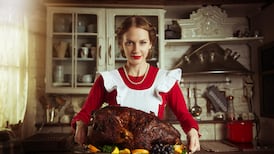Carrying your baby to full-term and then giving it away is preferable to terminating the pregnancy for some women, but there's no 'easy option'. Here, three mothers tell KATE HOLMQUISTabout putting their babies up for adoption
DOMESTIC ADOPTION is rare in Ireland – only 41 such adoptions occurred in 2008 compared with more than 1,000 per year in the last century. Adoption numbers are not recorded in a 2007 report by the then Crisis Pregnancy Agency. It found that in Ireland most crisis pregnancies resulted in a live birth: 75 per cent of mothers parented the baby, 6 per cent miscarried, 15 per cent had abortions and 1 per cent experienced still births. More than 5,000 women gave Irish addresses at UK abortion clinics in this report.
Birth mothers who choose open adoption think they’ve found a better way, but it’s not painless and, for the adopted children, it can be confusing.
THE RAPE VICTIM WHO RELINQUISHED HER BABY
Four years ago, 27-year-old Toni was raped on a holiday abroad. Having been made pregnant by her rapist, she says she spent a lot of her pregnancy in denial about the consequences, yet at the same time never considered an abortion. “From the second I found out I was pregnant, I knew I was in no position to be a single parent and I would not have considered a termination. I always believed everything happens for a reason. I think the child has a right to live.”
Throughout the pregnancy, “I thought it would go away”, Toni says. When her son was born, “I didn’t want to hold the child”. Through the hospital social worker, she was referred to a voluntary adoption agency, Pact. The agency counselled her about her choices over “three or four” sessions and when Toni made the final decision to give the baby up for adoption, they told her she could have a choice of several families and showed her their profiles. “I wanted nothing to do with it,” she says.
While the agency and the adopting family were offering an open adoption, Toni felt she couldn’t handle it. “In the beginning, I felt I was not able to . . . the first two years were very very hard. I did not want contact.” But eventually she opted for “semi-open” adoption. Twice a year she sends a letter and the birth parents respond with letters and photographs of her three-year-old son.
This is known as “letterbox” adoption. Asking how seeing a photograph of her son makes her feel, Toni is lost for words. He’s the child of her rapist, after all. “At some point, I will want to meet the child, but not for a while,” she says. “The parents will tell when the time is right. It’s their child.”
She believes that giving her son to a couple needing one was a way in which she could turn her own trauma into something good.
Toni isn’t in a relationship now and doesn’t know if she’ll have children in the future. “I’m still young. I travel. It’s not something that fits in to my life right now,” she says.
What would she advise another young woman in her situation? “I think it’s something they have to decide for themselves . . . I know I made the right decision. I would do nothing different about it now,” she says.
THE LONE PARENT WHO COULDN’T COPE WITH A SECOND BABY
“It’s not an easy thing to do, but it’s the easiest option . . . it makes it bearable,” says Elizabeth of open adoption. She reasons that if you have a termination, “you lose the child forever”.
If you choose to have the child adopted in an open adoption, you see your child twice a year and at least know that they have a good life with loving parents, she says.
“You are handing the baby over to parents to take care of the baby for you. It’s not a complete break. You are not saying goodbye forever.” When Elizabeth became pregnant with her second daughter, she already had a one-year-old girl. “There was no way I could have raised the [second] child. I was trying to do the best for everyone.” This was 20 years ago, when adoption had fallen out of favour and single motherhood was increasing. But while society supported single motherhood in theory and friends said kind words, Elizabeth’s own experience was of being stigmatised and abandoned in an inner city flat.
Today, Elizabeth’s daughters are aged 20 and 19. Elizabeth is in no doubt that her eldest daughter, who was bullied in school for not having a father and has suffered from economic disadvantage, has suffered from being the child of a lone mother.
Elizabeth believes girls need fathers involved in their lives, and says she has seen the benefit of having a father for her second daughter, who lives in “a big house in the country” with two loving parents. When Elizabeth sees how well her second daughter is doing, she regrets taking the advice of hospital staff to leave her name of her first daughter’s father off the birth certificate, advice she says she was given on the belief it would optimise her social welfare benefits.
For the past 19 years, Elizabeth has met her younger daughter twice a year in the company of the adoptive parents. She has sent letters, photographs and presents and received letters in return. “It was a comfort to know about her,” she says. She has always brought her first daughter along to the family meetings, and now the sisters are adults, they are feeling their way towards an adult friendship. “They will find their own path,” Elizabeth says.
She has had to deal with feelings of jealousy towards the adoptive parents, but “you have to be mature. Adoption is not a natural thing, so you are dealing with loss. You have to lower your expectations.”
Now that her second daughter is old enough to have an independent relationship with her, Elizabeth is keeping the door open and in the past few weeks they’ve had some “awkward” phone calls. Elizabeth hopes they are working toward a point where they might meet informally on their own; it’s up to her child to decide when, where and if this will happen.
For Elizabeth, “It’s been a process of becoming a better person and living with the pain and the lack, from giving up a baby.”
THE WOMAN WHO FELT SHE WAS 'A CHILD HAVING A CHILD'
“I don’t agree with abortion and there are so many couples that can’t have children and would like to adopt. I knew there was a family whose dream would come true,” says Fran of her decision 10 years ago at the age of 21, to have her baby son adopted. She has no regrets.
“The father was not around and I did not want to burden my parents, who were already helping my sister [who was a single mother] out.” Fran was counselled by the adoption agency Pact about her options during the month her newborn son was in a special care unit in hospital. By the time he was ready to leave hospital, Fran had decided that open adoption was for her. “The main factor was I knew I was mentally still a child and hadn’t the ability to look after myself and the baby. I was working two part-time jobs with erratic hours – finding childcare would have been impossible. And I was living in rented, student-style accommodation. It was midsummer and the house was quiet, but I knew when the students came back it wouldn’t be the right environment for a baby. Getting a council house or apartment on my own wasn’t feasible, it could have taken eight or nine years.”
She was given a choice of four profiles of adoptive families and picked one couple to meet. “It was scary. I didn’t know what to expect.” But they clicked and Fran was happy to let them be her child’s parents. For the past 10 years, they have met twice a year. Now that Fran is married and has a second son, she brings her son along so that the brothers can get to know one another.
“Having had a child adopted is something I don’t tell people. I know when they do hear they will have to take a dig, but I don’t like to keep it bottled up. My husband is very good about it. He comes along to the family meetings as well. It’s like a family meeting another family. When I see how well my son is looked after, I know I did the right thing.”
All names have been changed
What is an open adoption?
FROM THE 1950s to the 1970s, when coerced adoption was common in Ireland, many mothers suffered the trauma of being separated from their babies, never to see them again. This caused anguish for many of the women and psychological difficulties for their children struggling to trace them.
So many mistakes were made in adoption procedures over the past 50 years that in response, a few agencies – notably Pact – have pioneered “open adoption”, in which there are no secrets. Most people choosing hte adoption option now opt for an open adoption, though the traditional “closed adoption” still exists.
The process starts when a meeting takes place between birth and adoptive families prior to placement. This is when the terms of the adoption contact are agreed between the parties. It takes into consideration what is in the child’s best interest.
Both parties have a choice of face-to-face contact, which usually means the birth parents meeting with their child and the adoptive parents twice a year.
They may also have “letterbox” contact, where they send letters, presents and photographs through the adoption agency. The aim is for the adopted children to have a sense of their own unique identities by knowing their birth parents through an ongoing relationship, mediated by social workers. For the birth parents, there is the comfort of knowing how their child is developing.
See pact.ie for more information









